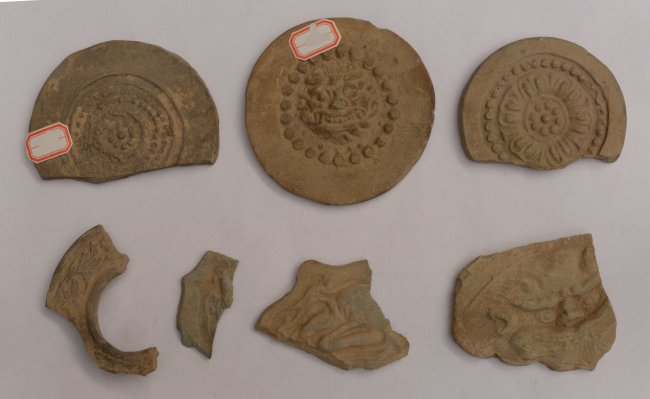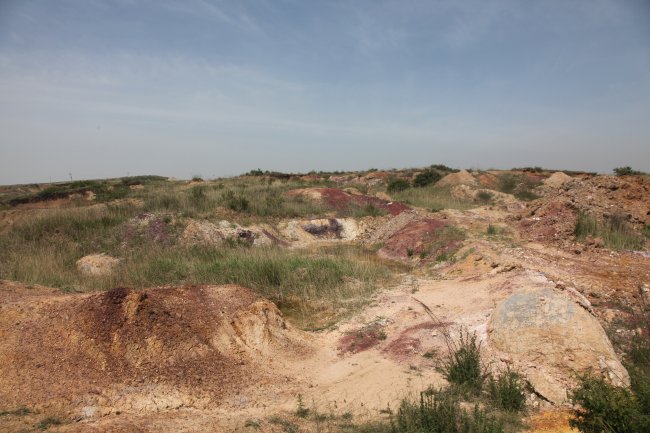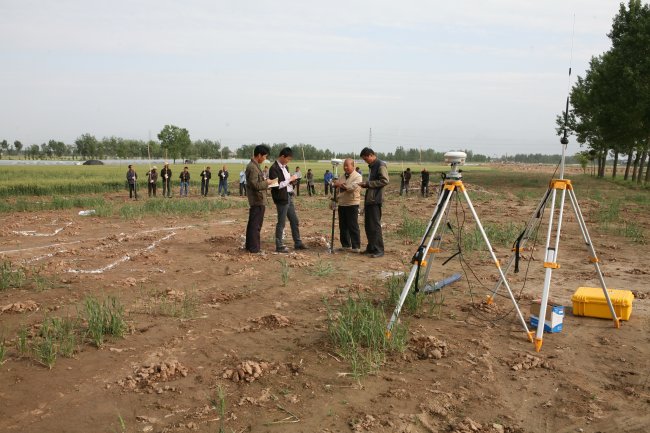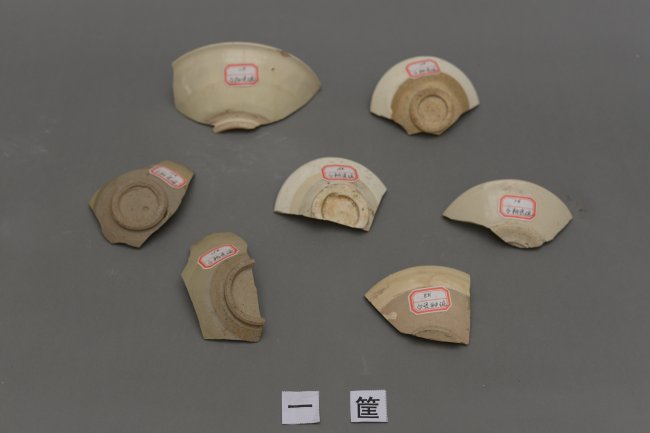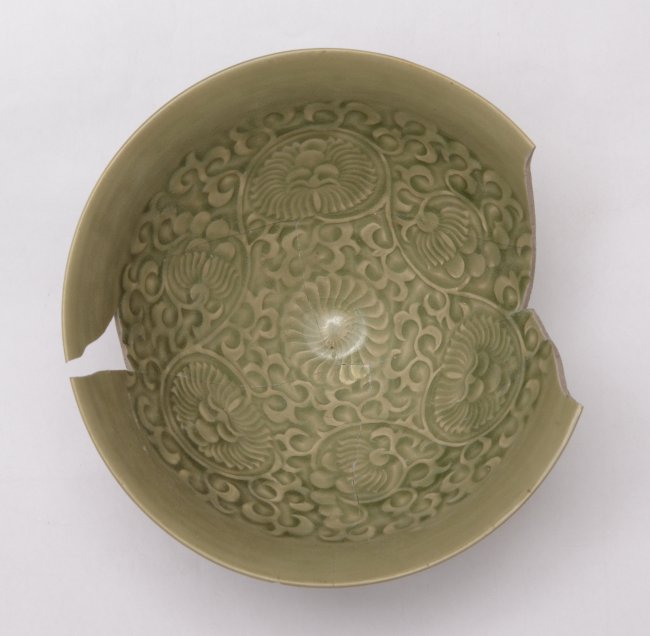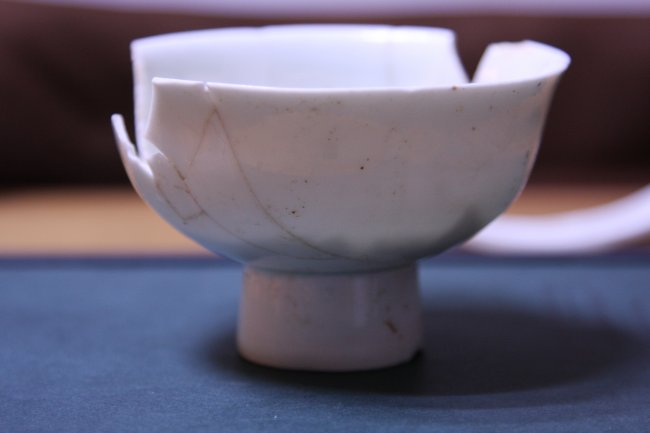Information
318 Ancient Kiln Discovered at Yingou Site, Fuping County via Investigation and Prospecting
In December 2011, due to the implementation of the
Project for the S106 Provincial Road’s Route Changing and the Comprehensive
Development of the Northeast District, Fuping County, the People’s Government
of Fuping County, Shaanxi Province applied to the Shaanxi Province
Administration of Cultural Heritage for the Project’s cultural relic investigation
according to the Cultural Relics Protection Law. Being approved by the Province
Administration, the Shaanxi Province Cultural Relic Exploration Co. Ltd,
together with cultural relics departments of Weinan City and Fuping County,
were decided to conduct the cultural relics investigation for the Project, and
they would present their results of investigation into report for the Province
Administration.
On the 6th February 2012, the Province
Administration of Cultural Heritage assigned the Shaanxi Province Cultural
Relic Exploration Co. Ltd to take up the cultural relics investigation and
exploration tasks of the Project. With the supports from local city and county’s
cultural relics departments, as well as the Taoyi Village, the Company
conducted the Project’s comprehensive investigation and exploration of the
cultural relics from the 6th February 2012 to the 10th December
2013; and it entrusted the Scientific Archaeology Group of Yingou Sites, Fuping
County, which was led and established by Zhejiang University in May 2015, to
conduct scientific analysis and research on the production’s site and period.
On the 17th March 2016, the Province
Administration of Cultural Heritage organised the Reporting Conference of the
Archaeological Exploration and Excavation at the Yingou Sites, Fuping County,
in which experts from the Research Group composed by Zhejiang University,
National Light Industry Porcelains Products Quality Testing Centre, Shanghai
Museum, the Scientific Archaeology Centre of Shanghai Institute of Optics and
Fine Mechanics, Chinese Academy of Science, and the Jingdezhen Institute of Inspection
and Quarantine Science and Technology, Jiangxi Province, released the
preliminary outcomes of the scientific archaeology at the Yingou Site. The
Shaanxi Institute of Archaeology then reported the future excavation plan of
the Site.
The
Outcomes of the Cultural Relic Investigation of Yingou Site
The Yingou Site locates at the Yingou Village,
Huazhu Township (now Huazhu District), Fuping County, lying at the second
terrace on the northern side of Wenquan River. Its north part goes as far as
the Yang River, while southeast part to Wenquan River. The Site’s overall terrain
slopes down from the Northwest to the Southeast in a shape of stairs with its
central terrain a little bit higher than the average. The Yingou Gully crosses
the central area from the South to the North, and the S106 Provincial Road goes
across the same part from the northeast to the southwest. The main landscape of
the Site includes agricultural field, village, and roads.
A great number of relics of ancient kilns, wells,
and ash pits have been discovered on both the east and west precipices of the
Yingou Gully. With the discovery of the cultural layer which was as thick as
0.7 metre on the terrace’s field ridges on both sides of the Gully, huge amount
of porcelains and pottery remains and architectural materials such as ancient
bricks and tiles were found remaining on the ground. During the Third National
Survey on Cultural Relics in 2008, the Yingou Site was considered as “unmovable
site of cultural relics”; in October 2011, the People’s Government of Fuping
County announced the Yingou Site to be the fourth instalments of cultural
relics at the county level.
To figure out the comprehensive distribution area
of the Yingou Site in the purpose of the Project for the S106 Provincial Road’s
Route Changing and the Comprehensive Development of the Northeast District,
Fuping County, the Shaanxi Province Cultural Relic Exploration Co. Ltd has made
detailed working plans, full preparations and consulted numerous literature
archives. By integrating fieldwork materials from interviews with local people,
the Company has conducted elaborate on-the-spot exploration in an extended 2
kilometres area that was bounded by Chenjiadian, Huazhu District to the south,
Gouyu Villiange, Xijian Village, and Jiubeishe Village, which were to the north
of the Yisang Road, to the north, Huayou Road to the west, and Guoyao Village
(S106 Provincial Road’s changing route) to the east. Eventually, the
distribution of the Site was depicted through the observation of the the relics
on the cliffs and ground ridges, and the layers’ accumulation conditions.
After detailed and considerate investigation, the
Yingou Village was defined as the central area of the Site’s distribution,
which from the south to the north reached a distance of 350 metres, while from
the east to the west 450 metres, covering an approximately 16 square kilometres
region. Within the central area, the accumulation of remains, relics and
cultural layers were extremely rich. The relics were highly observable in the
central area, and decreased gradually in line with the distance. To the 100
metres of the east of Guoyao Village, the southwest of the Jiubeishe Village,
and the west of Xijian village, as well as outside the 200 metres of the
southeast of Gouyu Village, the east of Huazhu Village, and the northeast of
Chenjiadian Village, relics of kilns, wells and ash pits could be seen, with porcelains
and pottery remains on the ground surface. According to the distribution of
these relics and remains, it could be concluded that the Yingou Site contained an
area which went east to the east of Guoyao Village and the southwest of Jiubei
Village, north to the north of Xijian Village, west to Gouyu Village and
Huadong Village, south to the south of Chenjiadian Village and Yingou Village.
During the investigation of the cultural relics,
980 pieces of porcelain, pottery, stone and other species were gathered and
collected, among which 863 were porcelains, 21 were potteries, 15 were stones,
18 were construction materials, and 63 were other species.
Among the total 863 pieces of porcelain, there were
648 pieces of celadon, 87 pieces of white porcelain, 66 pieces of black
porcelain, 19 pieces of tea-dust glaze porcelain, 5 pieces of light yellow
porcelain, 9 pieces of caramel porcelain, 2 pieces of grey porcelain, 2 pieces
of colourful porcelain, and 25 pieces of unglazed porcelain.
The total 20 pieces of pottery include 1 disk, 3 bowls,
3 tubs, 1 amphora, 1 earthen bowl, 1 clapboard, 2 crucibles, 4 inkstones, 2
molds, 1 lotus seat, and 1 bell.
As for the stone-made materials, 1 of them was a
stone brick, 1 a stone ball, 1 a stone inkstone, 1 a stone roller, 6 stone pestles,
4 stone mortars, and 1 tub.
The 18 construction materials were 5 pieces of
bricks and 13 pieces of tiles
The
Outcomes of the Cultural Relic Exploration of Yingou Site
To confirm the specific area of the Yingou Site,
its type, and distribution, the Shaanxi Province Cultural Relic Exploration Co.
Ltd has organised comprehensive exploration work on the cultural relics within
the Site for two times.
The first phase of the exploration ranged from the
6th February 2012 to 20th December 2013. The exploration
area reached 157,500 square metres, covering an area which went to as west as
Jinshan Avenue, as east as Huancheng East Road, as south as Huaide Avenue, and
as north as 500 metres north to the Huazhu Crematorium, all in the Huazhu
District. The coverage of this exploration mainly focused on the Yingou Site
Protection Area’s central area. Ancient kilns, ramparts’ remnants, and a number
of ash pits, ancient wells, and remains of roads were discovered. The second
phase of the exploration started from 15th September 2012 to 20th
December 2013. It expanded the detecting area from the central area to
2,137,103.84 square metres, discovering numerous ancient kilns, relics of buildings,
city walls, roads, ancient wells, ash pits, mines and cemeteries.
Through the two phases of exploration, a variety of
cultural relics and their preservation conditions were verified, and the
specific attribution of the Site, was cleared as well, involving Yingou
Village, Guoyao Village, Jiubeishe Village, Xijian Village, Gouyu Village,
Huadong Village, the Funeral Management Office, Huazhu Factory of Colour Steel
and Tiles, and Huazhu Factory of Bricks, etc. Its southwest corner was Chenjia
Village (GPS coordinate N34°47′01.67″, E109°11′59.95″, H465m), southeast corner
the south part of Guoyao Village (GPS coordinate N34°47′20.87″, E109°12′43.15″,
H467m), northeast corner Jiubeishe Village (GPS coordinate N34°48′02.37″, E109°12′21.46″,
H484m), northwest corner Gouyu Village (GPS coordinate N34°47′56.86″, E109°11′42.63″,
H489m). The Site occupied an area around 2.3 square kilometres, with a 1600
metres’ distance from its east end to west end, while a 1800 metres’ one from
the south end to the north end.
1910 remnants were discovered during the two phases
of explorations, among which 318 were kilns, 832 ash pits, 234 remains of
mining materials, 145 ancient wells, 2 rammed earth city wall foundations, 8
houses, 10 roads, 12 entrenchments, 112 tombs, and 229 earth pits.
Among the 318 kilns, there were 289 in round shape,
17 in ellipse, 6 in semicircle, and 6 in shape of a hoof.
The total 832 ash pits included 39 round ones, 420
ellipse ones, 115 strip ones, and 258 in irregular shapes.
Among the 234 remains of mining materials, 144
green ones, 33 red ones, 54 yellowish-green ones, 2 white ones, and 1 black one
were found.
The 145 wells had 129 ones in shape of round, while
16 in ellipse.
The 2 rammed earth city wall were distributed in a
shape of “┻”, with a
ruined east-west part with a length of 340 metres, while the width of which were
between 6 to 10 metres from the south to the north. The rammed earth had a
depth between 1 to 2 metres to the ground, and a width of 1 metre. The width of
the single rammed level ranged from 0.08 to 0.1 metre. Inside the rammed earth
found tiles fragments, pottery fragments, ash of grass and wood, and charcoal
particles; the remained south-north city wall remnant was as long as 164
metres, and as wide as 6 to 8 metres. Its rammed earth also had a depth between
1 to 2 metres to the ground, and a width between 0.8 to 1 metre. The width of
the single rammed level, too, ranged from 0.08 to 0.1 metre. Similarly, tiles
fragments, pottery fragments, ash of grass and wood, and charcoal particles
were discovered.
Among the 8 building ruins, 6 of them were in shapes
of rectangle, 1 in strip, and 1 in trapezoid.
As for the 112 tombs, there were 88 ancient tombs
and 24 modern ones. Most of the ancient tombs could be dated to Han and Tang
Dynasty, among which 40 were catacombs, 18 square combs with a single passage, 8
vertical shaft tombs, 2 tombs with domatic tomb passage, and 20 extended vertical
shaft tombs.
The results of the cultural relics exploration
confirmed that the Yingou Site covered an area of 2.3 square kilometres. Within
the sites remained the ruin of the ancient city, ancient kilns, ancient
cemeteries. Besides, a large number of porcelain fragments of the Tang Dynasty,
Five Dynasties and Ten Kingdoms period, and the Song Dynasty, as well as
remains of construction material like bricks and tiles of the Tang Dynasty were
discovered on and underneath the ground.
To make sure the historical and cultural value of
the Yingou Site, the Shaanxi Province Cultural Relic Exploration Co. Ltd,
together with the Centre for Cultural Relics Preservation and Identification of
Zhejiang University, the National Light Industry Porcelains Products Quality
Testing Centre, and other higher education and research institutes, employed
scientific archaeological methods to test on the porcelain species and to
conduct porcelain industrial studies of the Yingou Site. In addition,
scientific measures were adopted to confirm the porcelain species’ site and
period. Some great progresses have been made until now.
After the investigation and exploration on the
cultural relics of Yingou Site, Fuping, the Shaanxi Province Cultural Relic
Exploration Co. Ltd edited the outcomes into volumes, which was published by
Sanqin Press as Investigations and
Explorations of Yingou Site, Fuping County.
The
Scientific Archaeological Methods Used in Yingou Site
It is difficult to conduct further field
archaeological work at the Yingou Site, Fuping County, due to its age-old
remains, and complicated and damaged stratums. Therefore, scientific
archaeological methods were employed for studies and identifications of the
relics, remains and remnants.
In May 2015, the Shaanxi Province Cultural Relic
Exploration Co. Ltd assigned Zhejiang University to invite Professor Shaohua
Zhou from Zhejiang University, Professor Chuan Li from the National Light
Industry Porcelains Products Quality Testing Centre, Researcher Junding Xia
from the Shanghai Museum, Researcher Qinghui Li and Dr. Song Liu from the
Scientific Archaeology Centre of Shanghai Institute of Optics and Fine
Mechanics, Chinese Academy of Science, and Director Wenzan Yuan and Tao Fang
from the Jingdezhen Institute of Inspection and Quarantine Science and
Technolog, to establish the Yingou Site, Fuping Scientific Archaeology Group,
whose responsibility was to scientifically analyse and research on the
excavated objects’ site and period.
All species analysed by the Group were provided by
the Shaanxi Province Cultural Relic Exploration Co. Ltd in line with the
materials from the Investigations and
Explorations of Yingou Site, Fuping County (2012-2013) and from field archaeological investigations and collections. The
group selected over 170 pieces of species from the excavated objects from
Yingou as research objects and processed the early analysis on material samples
extracted from the archaeological investigations.
The main significance of the research included:
scientifically and reasonably confirmed and positioned the Yingou Site’s
cultural essence and period; discussed the relationship between the Yingou Site
and the Dingzhou Kiln (鼎州窑) recorded by written
materials in the Tang Dynastry, with the hope to reveal the truth of the
Dingzhou Kiln lasted for thousands of years; discussed the relationship between
the Yingou Site and Chai Kiln (柴窑) recorded by historical
literature, possibly to decode the mystery of the Chai Kiln haunting the
Chinese archaeological world; solving the problems of Dingzhou Kiln and Chai
Kiln would be the landmark event of the Chinese porcelain history, through
which not only the current history of the Chinese porcelain might need to be
rewritten, but also the status and effects of the Shaanxi Porcelains would be
improved in the Chinese porcelain history; the research would further provide
scientific evidence for local cultural relics’ scientific preservation and effective
usage and for the exploration of the possibility of the transportation of porcelains
via the “silk road” in the Tang Dynasty and the Five Dynasties and Ten Kingdoms
period.
The main content of the research contained: the re-study
on the literature material of Fuping area’s historical trajectory; the research
of the Dingzhou Kiln of the Tang Dynasty and the Chai Kiln in ancient
literature records; the archaeological, craft and technological, material
science research on the excavated objects from the Yingou Site and the
identification research on their site and period; the function of the objects
(including living and social perspectives) and their cultural connotations; the
historical position and significance in the Chinese porcelain history of the
Yingou Kiln, Fuping County.
The technological difficulties included: due to the
unique feature of the Yingou Site, probing into the relationship between the
Site and the Dingzhou Kiln of the Tang Dynasty, as well as between the Site and
the the Chai Kiln of the Five Dynasties and Ten Kingdoms period, were
simultaneously the point of complication and innovation. Once the Site is
regarded as the Tang Dingzhou Kiln and the Chai Kiln of the Five Dynasties and
Ten Kingdoms period, the unsolved mystery for over a thousand years in the
history of the Chinese ancient porcelain research will be revealed, which will
mark a landscape in the history. Hence, the Site will highly possible to be
included as a State-level Key Protected Object, changing the current porcelain history
of China: the research of Yingou Kiln would absolutely improve the historical
status and significance of the Shaanxi porcelains in the developmental history
of Chinese Porcelains.
To compensate the lack for materials of the field
archaeology, this research employed the methods of scientific archaeology to
confirm the essence of the Yingou Site. This was a new attempt in modern
archaeological methods, and its maturation during the development of
archaeology has leveraged the traditional archaeology to a new level. Modern
archaeology is no longer a process which consists of the addition of literature
archaeology and field archaeology. It further should include the process of
scientific archaeology.
The theories, methods, and measures of scientific
archaeology must be reliable, advanced, and scientific; which requires a set of
utmost progressive theories and methods, modernised devices and equipment, and experienced
professional talents. Theories, methods, equipment, and professions are all
indispensable for this research. Therefore, all scientific experiments of the
research were carried out by the Research Centre of Cultural Relics Materials
of Zhejiang University, the Scientific Archaeology Centre of Shanghai Institute
of Optics and Fine Mechanics, Chinese Academy of Science, the Scientific
Archaeology Centre of the Shanghai Museum, and the National Light Industry Porcelains
Products Quality Testing Centre.
For the first time, this research adopted the
theories and methods of scientific archaeology, employing the most progressive
investigation methods worldwide to date the site and period of the objects. A. Energy
Dispersive X-ray Fluorescence (EDXRF) (for the chemical components of the
glaze-body). B. confocal laser Raman spectrometer (LRS) (for the analysis of
the material structure). C. Keyence Machine Vision Inspecting System CV-3500
with 25 to 500 times continuing adjustment (for microstructural analysis of the
glaze-body). D. optical coherence tomography (OCT) (for the image analysis of
the glaze layer’s 2D and the fraction’s 3D structures). E. TL – used the RISOTL/OSLREADERMODELDA-20
detector produced by the Risø DTU National Laboratory for Sustainable Energy (thermoluminescent
dating technology).
Using the principles of material science and craft
technology to conduct research on unearthed remains from the Site would help
solve the originating problem of these porcelain species, while the principle
of the thermoluminescent dating technology would date the species’ period.
A comprehensive research was carried out via three
methods by the research group. First, they thoroughly made understandable the
historical changing trajectory, belonging, and area of the Yingou Site via
literature review. Second, the excavated objects were classified and compared,
and some representative object species were further categorised to confirm its
essential function; meanwhile, through physical, chemical, and material test
and analysis on certain typical objects, their origin was scientifically
studied, while through the thermoluminescent dating technology, their period
were confirmed. Third, on-spot investigations that focused on sampling and
analysing the mining materials surrounding the Site were included, which mainly
emphasised the field investigations and confirmations on the porcelain kilns,
using the principles of craft technology to study the glaze-body’s components
and kiln technology of the porcelain species unearthed from the Site.
The Outcomes of the Scientific Archaeology at the Yingou Site
According to the result of the thermoluminescent dating test on typical species exploited from the Site, it could be concluded that the Yingou Site was a significant remnant of porcelain-made kiln factory from the mid-to-late Tang Dynasty to the Northern Song Dynasty. The experiments showed that the species of the bluish white porcelain with yellow earth-made foundation could be dated to the Five Dynasty and Ten Kingdoms period and the early Northern Song Dynasty. The species of the celadon bowl with pattern in lines and lotus feet were dated from the late Tang Dynasty to the Five Dynasties and Ten Kingdoms period. There was one piece of species, a bowl with folding fan patterns and engraved foundation, which was in the same style with the celadon made by Yaozhou Kiln. It was a work made between the Five Dynasties and Ten Kingdoms period to the early Northern Song Dynasty. And the two fine-made transparent species of the bluish white porcelain were dated from the early to middle of the Song Dynasty. Therefore, the porcelain species excavated from the Yingou Site shared the cultural features of the late Tang Dynasty – early Northern Song Dynasty period.
The field investigation on the raw materials
surrounding this area suggested that the raw materials for porcelain making
were quite sufficient. According to the analytical data on the mining material
species generated with the help of the X-ray diffractometer and the Raman
technology, kaolin clay, sericite porcelain stone, calcite stone, Zijin clay
with high volume of hematite, and quartz mines, etc. The glaze stone here was a
mixture of mining materials including the microcrystalline of calcite stone,
mica, and quartz, etc., hence the Site used to have the condition to made its
own glaze. In regardless white porcelain, bluish white porcelain, celadon, or
black porcelain, all of their raw materials could be found in this area – the Site
had all raw materials to produce all kinds of porcelains.
Due to the fact that a diversity of porcelains
including white porcelain, bluish white porcelain, celadon, and black porcelain
were discovered in this Site, it is reasonable to believe that since the Five
Dynasties and Ten Kingdoms period, the kiln workers here had already
respectively mastered the formula and techniques to produce the glaze – body binary
(possibly more than the binary). This technique was far ahead than its
counterpart employed by Jingdezhen (the Yuan Dynasty) for almost 300 years. The
kiln used to produce white porcelain, bluish white porcelain, celadon, and
black porcelain simultaneously, among which the bluish white porcelain enjoyed
the highest quality. The abundant mining materials located around the Site’s
area were supportive to this kind of techniques, which maintained the producing
of various porcelains in the same kiln.
The comparative study between the transparent bluish
white porcelain from the Yingou Kiln and its fine-made counterpart from the Lv’s
Family Cemetery at Lantian were carried out with the EDXRF detector. Through
the comparison between their glaze-bodies’ chemical components, it was found
that their basic elements were the same, while both were obviously different
from the bluish white porcelain excavated from the Jingdezhen Pit. Therefore,
the bluish white porcelains species from the Lv’s Family Cemetery and the
Yingou Site shared the same origin, and the Site should be the place of origin.
Such high quality, high class, and high standard productions were both at the
top level, which were likely not coincidence.
The field investigation at the Ganniyuan area, Baimiao
County within the region discovered kilns that could be dated to the late Tang
Dynasty to Song Dynasty. A number of kiln tools were found on the ground, among
which the M-shape bowl confirmed that the kilns in this area were the ones for
porcelain making which required high temperature. This discovery provided fact
evidence to make sure the nature of the kilns in this area. Additionally,
porcelain clay was also discovered at the field, which corresponded to the
convention of the Tang and Song Dynasty to establish kilns at the producing
area of the mining raw material.
By analysing the unearthed species from the Site with
a viewpoint of the craft technology, both the celadon and the white porcelain’s
thickness of the body, equality, and round feet were very regulated. And their
kinds were also diversified yet regulated as well. Such evidences suggest that
the tools and moulds used here were very advanced, and the wheelers here had a
high accuracy. In particular, the bluish white porcelain, which had an
exquisite body and a high porcelain comprehension, proved that its
transparency, whiteness of the body, strength, and producing temperature, etc.,
had all reached the highest level of the Jingdezhen Kiln in the Ming Dynasty.
It had a high vitreous level of the glaze, a well combined glaze-body
structure, a high-quality glaze surface, elegant engravings, and sophisticated
craft techniques. The types of ceramic fragments found in the Site were very
rich, and their craft techniques were considerably advanced, especially the
white porcelain (bluish white porcelain) could be ranked top in its time, being
quite rare in the Chinese history of porcelains. From this perspective, it
could be concluded that the kiln production at the Yingou Site should have its
own remarkable position in the history of the Chinese porcelains.
Category: English
News
Information
Key words:

